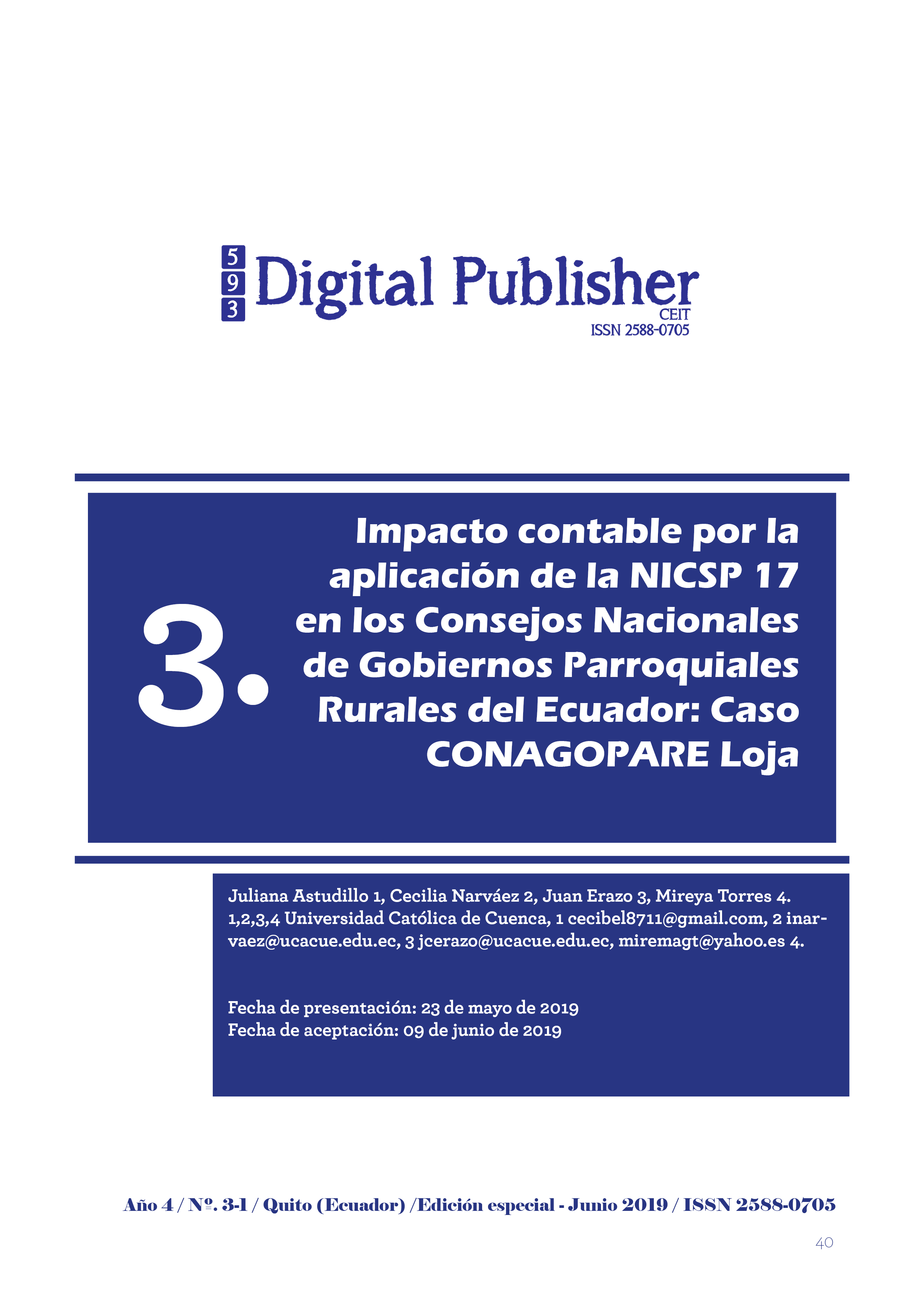Accounting impact by the application of IPSAS 17 in the National Councils of Rural Parish Governments of Ecuador: Case CONAGOPARE Loja
Main Article Content
Abstract
In the last decade, several Latin American countries have introduced reforms to improve the administration of public finances, mainly in budget management and fiscal policy. Consequently, the International Public Sector Accounting Standards (IPSAS) have been set up in good practice standards on accounting and financial information of public entities at the global level.
In this sense, in accordance with the strategy of the National Government of Ecuador to manage public finances on a sustainable, responsible and transparent manner, it established for the fiscal year 2019 the implementation of IPSAS, thus achieving significant progress in alignment with international standards and strengthening the implementation of best practices and knowledge transfer.
After a brief analysis of the IASB role in the international accounting harmonization process, this article presents a methodological procedure for recognition, measurement and property register, plant and equipment, under the IPSAS 17, on that basis, presents the models of accounting record for the acquisition and revaluation by the increase or decrease in the value of the goods. Finally, the article presents a series of reflections about the practical difficulties the CONAGOPARE Loja shows in this kind of account processing, and possible solutions, which, in the opinion of the author, could be considered by the respective authorities.
Downloads
Article Details
1. Derechos de autor
Las obras que se publican en 593 Digital Publisher CEIT están sujetas a los siguientes términos:
1.1. 593 Digital Publisher CEIT, conserva los derechos patrimoniales (copyright) de las obras publicadas, favorece y permite la reutilización de las mismas bajo la licencia Licencia Creative Commons 4.0 de Reconocimiento-NoComercial-CompartirIgual 4.0, por lo cual se pueden copiar, usar, difundir, transmitir y exponer públicamente, siempre que:
1.1.a. Se cite la autoría y fuente original de su publicación (revista, editorial, URL).
1.1.b. No se usen para fines comerciales u onerosos.
1.1.c. Se mencione la existencia y especificaciones de esta licencia de uso.
References
Angulo, J. A. (2004). Normas IASB: la primera vez. Universia Business Review, 111. Obtenido de http://www.redalyc.org/articulo.oa?id=43300110.
Buyatti, O. (2011). Normas Internacionales de Información Financiera (primera ed.). Buenos Aires: Graphic productión.
Campuzano Vásquez, J., Chávez Cruz, R., & Chávez Cruz, G. (2015). Elementos Básicos de Contabilidad (Primera ed.). Machala: UTMACH. Obtenido de http://repositorio.utmachala.edu.ec/handle/48000/6745.
Chávez Cruz, G., Campuzano Vásquez, J., & Alvarado Avilés, F. (2015). Contabiilidad Intermedia. Machala: UTMACH. Obtenido de http://repositorio.utmachala.edu.ec/handle/48000/6743.
Coral Delgado, L. d. (2014). Contabilidad Universitaria (Séptima ed.). Bogotá: McGrawHIll.
Díaz Becerra, O. A., Durán Rojo, L. A., & Valencia Medina, A. (2012). Análisis de las diferencias entre el tratamiento contable y el fiscal para los elementos de propiedades, planta y equipo: el caso peruano. Contabilidad y Negocios, 8. Obtenido de http://www.redalyc.org/articulo.oa?id=281624914002.
Fierro Martínez, Á. M., & Fierro Celis, F. M. (2015). Contabilidad General con enfoque NIIF para las PYMES. Bogotá: Ecoe ediciones. Obtenido de https://books.google.es/books?hl=es&lr=&id=-6MwDgAAQBAJ&oi=fnd&pg=PT10&dq=libro+sobre+niif&ots=9pTKe5SQFL&sig=W2c0-oHzRQafqX1t4TO0wdk7e2E#v=onepage&q=libro%20sobre%20niif&f=false.
Galindo Alvarado, J. F., & Guerrero Reyes, J. C. (2015). Contabilidad Gubernamental. Grupo Editorial Patria, S.A. de C.V.
Gómez Villegas, M., & Montesinos Julve, V. (2012). Las innovaciones en contabilidad gubernamental en Latinoamérica: el caso de Colombia. INNOVAR. Revista de Ciencias Administrativas y Sociales, 18. Obtenido de http://www.redalyc.org/articulo.oa?id=81824864003
Ijiri, Y., & Kaplan, R. (2007). Depreciación probabilística y sus implicaciones para la depreciación de grupos. Revista de Ciencias Administrativas y Sociales, 171. Obtenido de http://www.redalyc.org/articulo.oa?id=81802911.
Hervás Oliver, J. L. (2005). La revalorización de activos fijos. Contraste empírico de un modelo financiero de elección contable. Investigaciones Europeas de Dirección y Economía de la Empresa, 31. Obtenido de http://www.redalyc.org/articulo.oa?id=274120423002.
Holm, H. (2012). NIIF para pymes teoría y práctica. Guayaquil: Parque empresarial Colon.
IASB. (27 de 12 de 2015). Obtenido de https://www.ifac.org/system/files/publications/files/nicsp-17-propiedad-plan.pdf.
Medina Castillo, W., y Morocho Román, Z. (2015). Contabilidad Gubernamental I. Machala: Ediciones utmach.
Mendoza Zamora, W., Cevallos Ponce, G., Santistevan Villacreses, K., & Parrales Reyes, J. (2018). La contabilidad gubernamental como herramienta de gestión en la administración pública. Polo de Conocimiento, 131.
Ministerio de Finanzas. (2016). Acuerdo 0067.
Monge, P. (2005). Las Normas Internacionales de Contabilidad. Actualidad Contable Faces, 36-37. Obtenido de http://www.redalyc.org/articulo.oa?id=25701005.
Orozco Cadena, J. (1997). Contabilidad General (Primera ed.). Quito: Emanuel Editores.
Peña, A. E., & Bastidas, M. C. (2007). La ética: fundamento en la adopción de las normas internacionales de contabilidad. Actualidad Contable Faces, 119. Obtenido de http://www.redalyc.org/articulo.oa?id=25701411.
Rendón Álvarez, B., Montaño Orozco, E., & Gaitán León, G. (2013). Las NIIF y su impacto en las cooperativas en Colombia a diciembre 31 de 2011. Cuadernos de Administración, 179. Obtenido de http://www.redalyc.org/articulo.oa?id=225029797007.
Romero López, J. (2000). Contabilidad Superior. México: Programas Educativos S.A.
Ugarte, S. (2003). La Contabilidad Gubernamental como factor hacia la calidad total de la gestiòn financiera.
Vasconez Arroyo, J. V. (2004). Contabilidad General para el siglo XXI (Tercera ed.). Quito: Imprenta Mariscal.
Zepeda Pineda, A., Aguilar Canesco, E., & Salazar Herrera, M. E. (2014). La armonización contable en México y su relación con la educación superior. Ciudad Universitaria, 4. Obtenido de http://congreso.investiga.fca.unam.mx/docs/xix/docs/8.02.pdf

